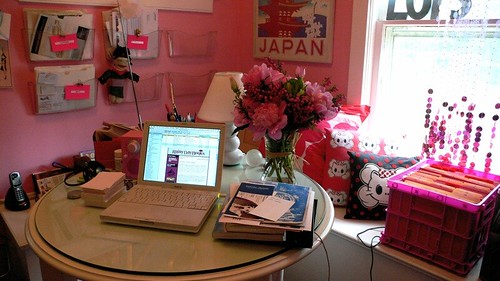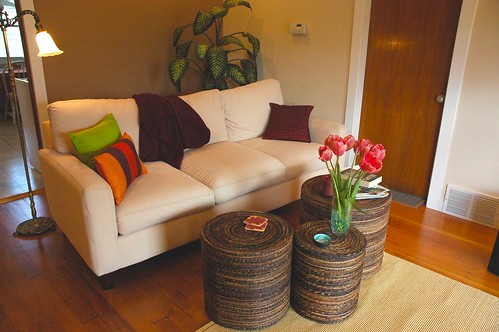Top Ten Favorite Decorating Things
by Charlotte Siems
Décor in our first home: a plaid couch, a lone poster tacked to the wall (really) and an aquarium with a green grass snake. Not to mention dirty clothes and papers strewn about, but we won’t go there.
It took me a few years to find my decorating style, let alone figure out how to clean the place.
In some ways, learning about my taste in decorating was a process of self-discovery. I finally realized that it was okay to like lace and roses in my bedroom, even if someone else didn’t (unless that person was my husband, and fortunately, he didn’t mind).
A feminine bedroom is a nice contrast to masculinity, and can even create an atmosphere of feeling pampered, but I digress.
After many years of decorating on a slim budget, here are my Top Ten favorite decorating things at
This Lovely Place:
1. Plates – There are plates on the wall and on plate holders in my bedroom, my office corner, kitchen, bathroom and living room. Mostly antique, but not all.
2. Clocks – Big ones, small ones. Some that don’t work but look cool.
3. Books – Not only do we have numerous bookshelves throughout the house, but books come in handy for tabletop arrangements and making lamps taller. Double points for using titles that fit the season.
4. Fabric – Curtains, pillow covers, table runners, tablecloths and more. New pillow covers can change the look of the couch!
5. Garland – Not just for Christmas, seasonal garlands add a nice touch for holidays. Hearts for Valentine’s, clover for St. Patrick’s Day, eggs for Easter. Use on the kitchen chandelier, fireplace mantel and surface displays, like the top of the TV armoire.
6. Plants – Okay, I don’t have a green thumb, but I like a pretty geranium in the kitchen window, especially in the winter.

7. Glass Jars – Especially large, decorative ones with lids. Fill with fake fruit or berries in the summer, cotton and a snowman in the winter, speckled bird eggs and a nest in the spring, and leaves and acorns in the fall.
8. Candles – Great for bringing in the comforting sense of smell. Match the scents (and colors) to the season.
9. Closed Storage – This isn’t exactly a decorating item, it’s more of a way to keep clutter at bay so the decorating shows up.
10. Dishes – Platters, cups and saucers, bowls, teapots, pitchers and more become part of a shelf or table arrangement.
These everyday items are handy for use-what-you-have decorating. Most can be found at discount stores like Ross or TJ Maxx, garage sales or thrift stores. Look at your stuff with new eyes: could you repurpose something or move it to a new room?
Whatever you do, make sure you use Your Favorite Things in your decorating. Let your home be an expression of your personality and what you like!
Do you have a favorite thing to decorate with? Leave a comment below!
**************
Charlotte Siems is a home-maker, home manager, T-Tapp Trainer, teacher, speaker and author. Her story of losing over 100 pounds with T-Tapp has encouraged thousands of people all over the world. She specializes in making home management and T-Tapp "doable" for real people and real life. She is happy to be a wife and mother of twelve children whom she has successfully taught at home for 25 years.
This article was first published by This Lovely Place with Charlotte Siems. To receive Charlotte's free guide "Secrets for Keeping Your Home Together When You Feel Like Your Life is Falling Apart," go to ThisLovelyPlace.com.

























